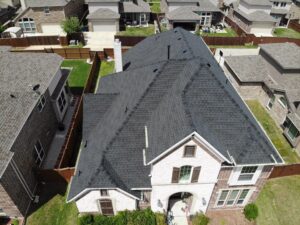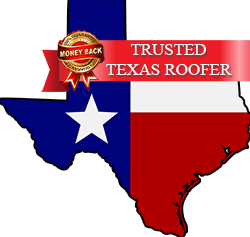Spring and summer in North Texas bring unpredictable weather, and one of the most intense challenges homeowners face is the tornado and storm season. As we approach these high-risk months in the Dallas-Fort Worth area, it’s important to ensure your roof is ready to withstand strong winds, heavy rain, and potential hailstorms. With proper preparation, you can minimize the risk of damage and keep your home safe.
In this blog, we’ll guide you through the steps to prepare your roof for tornado and storm season in DFW, helping you protect your property and avoid costly repairs.
1. Inspect Your Roof Before Storm Season
Regular Roof Inspections are Key
Before the storm season hits, it’s crucial to have a professional roof inspection. A roofing expert will look for any signs of wear and tear that could be exacerbated by strong winds or heavy rain. Key areas to focus on include:
- Missing or damaged shingles: Wind can easily lift and tear off damaged shingles, leaving your roof vulnerable to leaks.
- Flashing around chimneys and vents: Flashing is vital for waterproofing, and damaged flashing can lead to leaks during heavy rainfall.
- Gutter and downspout functionality: Clogged or damaged gutters can cause water to pool on the roof, which could lead to leaks or roof deterioration.
- Signs of aging or wear: If your roof is older, it may not withstand harsh conditions as well as a new one. The roofing contractor can assess whether it’s time for a replacement or repair.
Why It’s Important
A thorough inspection can help catch small issues before they turn into major problems during storm season. Fixing these minor repairs early can save you from larger, more costly repairs later.
2. Trim Trees and Clear Debris Around Your Roof
Prepare Your Yard for Storms
In DFW, storms can bring down tree branches and debris, which can cause serious damage to your roof during high winds. Take the following steps to prepare your yard:
- Trim overhanging tree branches: Ensure that no branches are hanging near or over your roof, windows, or power lines. Trim any limbs that are weak or could snap during high winds.
- Remove dead trees or branches: Dead or decaying trees are more likely to fall during strong storms. Having them removed can prevent damage to your roof, windows, or even your car.
- Clean gutters and downspouts: Accumulated leaves and debris can clog your gutters, preventing proper water drainage during heavy rain. Clean out the gutters regularly to ensure water flows freely away from the roof.
Why It’s Important
Clearing your yard of potential hazards can significantly reduce the chances of roof damage caused by falling debris or clogged gutters during a storm.
3. Reinforce Your Roof’s Structural Integrity
Strengthen the Roof to Withstand Winds
High winds are a major threat during tornado and storm season in DFW. While no roof is completely immune to wind damage, reinforcing certain areas can reduce the risk. Some steps to take include:
- Roof decking and trusses: Ensure that the roof decking (the layer beneath the shingles) is securely attached to the trusses. This will help the roof stay intact during high winds.
- Storm collars and hurricane straps: If you live in a particularly high-risk area for tornadoes, consider installing additional storm collars around chimneys and adding hurricane straps to improve the roof’s stability.
Why It’s Important
Strengthening your roof can help it withstand winds up to 130 mph or more, which is common in severe thunderstorms and tornadoes.
4. Upgrade to Impact-Resistant Roofing Materials
Invest in Stronger Materials
If your roof is aging or you live in an area that frequently experiences severe storms, upgrading to more durable roofing materials could be a wise decision. Some options that can better withstand storm damage include:
- Impact-resistant shingles: These shingles are specially designed to endure hail, wind, and other storm-related impacts without sustaining significant damage.
- Metal roofing: Metal roofs are extremely durable and can handle high winds, heavy rain, and hail better than traditional asphalt shingles.
- Modified bitumen or rubber roofing: These materials offer extra protection against water infiltration and can withstand high winds.
Why It’s Important
Impact-resistant and storm-ready materials help protect your roof from severe weather and can reduce the need for repairs after every storm. While the initial investment may be higher, these materials can save you money in the long run by reducing the frequency of repairs.
5. Ensure Proper Attic Ventilation
Ventilate Your Attic to Prevent Damage
Proper attic ventilation is essential in storm-prone areas, as it helps regulate temperature and moisture levels. Poor ventilation can lead to:
- Roof damage from heat buildup: During the summer, heat can accumulate in your attic, leading to premature aging of your roof and potential damage to shingles.
- Moisture problems: Without proper airflow, moisture can build up in the attic, which can weaken the roof structure and lead to mold growth, particularly after heavy rainstorms.
Why It’s Important
Proper ventilation ensures that your attic stays cool and dry, reducing the risk of roof damage and extending the lifespan of your roofing system. It can also help prevent ice dams if your area experiences occasional winter storms.
6. Invest in Storm-Proof Roof Features
Add Protective Roof Features
Certain roof features can enhance your roof’s ability to withstand storms:
- Roof edge protection: Install edge flashing or protective barriers along the edges of your roof to prevent wind from lifting shingles during high winds.
- Waterproof coatings: Consider applying a waterproof sealant to your roof to protect it from leaks caused by heavy rain and wind.
- Impact-resistant skylights: If your home has skylights, consider installing impact-resistant versions that can withstand hail or flying debris.
Why It’s Important
By adding these storm-proof features, you reduce the chances of significant roof damage during tornadoes and severe storms. These additional measures enhance your home’s overall weather resilience.
7. Have an Emergency Plan for Roof Damage
Be Prepared for the Worst
Despite all of your preparations, storms can still cause unexpected damage. Here’s how to be ready for potential roof repairs after a storm:
- Have emergency contact information for your roofing contractor: Keep the number for Trophy Roofing and Construction handy. We’re available for emergency roof repairs, inspections, and assistance after storms.
- Document roof damage: If your roof sustains damage, take pictures or videos for insurance purposes and contact your roofing contractor for an assessment.
- Temporary fixes: If you experience leaks or missing shingles after a storm, contact a contractor for emergency tarp services or temporary fixes to prevent further damage.
Why It’s Important
Being prepared with an emergency plan ensures that you act quickly and efficiently in the event of roof damage, minimizing repair costs and preventing further complications.
How Trophy Roofing and Construction Can Help
At Trophy Roofing and Construction, we understand the unique challenges posed by tornadoes and severe storms in DFW. Our experienced team offers:
- Pre-storm roof inspections: We’ll thoroughly inspect your roof before the storm season to identify any vulnerabilities and recommend the best course of action.
- Emergency roof repairs: After a storm, we provide prompt, professional repairs to secure your home and prevent further damage.
- Roof replacements and upgrades: If your roof is nearing the end of its lifespan or is not storm-ready, we offer high-quality roofing materials and installation services.
- Insurance claim assistance: We can help you navigate the insurance claims process, making sure you get the coverage you need to repair or replace your roof.
Contact Us Today to Prepare Your Roof for Storm Season
Don’t wait until storm season is in full swing—contact Trophy Roofing and Construction today to schedule a roof inspection and ensure your home is ready to face the unpredictable weather in DFW. Our team is dedicated to keeping your roof safe, secure, and storm-ready.



